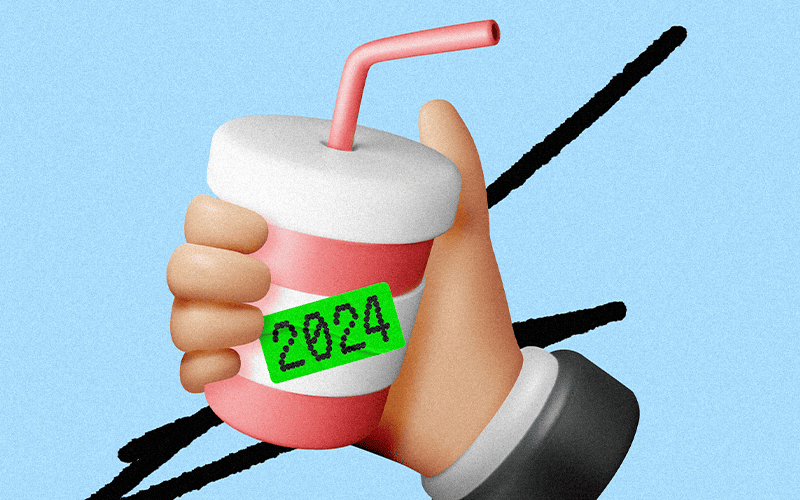Thirsty in 2024? You will be.

Let’s talk beverage trends—coming off the Super Bowl (both the parties and commercials) and recovering from Dry January, now is the perfect time to reflect on what’s new and trending in the world of refreshments. In 2023, the U.S. beverage industry was valued at $146B, with expectations for constant and continued growth estimated at about 1.7% annually until 2027. In addition to being valued in the billions, the State of the Specialty Food Industry reported that due to innovation, beverage sales have consistently outpaced food sales in recent years. So, what and how are we drinking in 2024?
Wellness
First and foremost, wellness is a priority for consumers and it is here to stay. We are seeing options for “functional fizz,” making the recent fizzy water trend more wellness oriented by including concentrations on natural and simple ingredient lists, kombucha, or elevating the traditional sodas.
The biggest player in the field is the ever-trending Poppi soda. Poppi brands themselves as the “future of soda,” with a clever combination of fruit juice, apple cider vinegar, and inulin prebiotics hidden behind the traditional soda flavors you already enjoy. The previous SharkTank investment has turned into a social media frenzy with TikTok songs (Jake Shane please get out of my head), their trending Poppi sweatsuit from last summer, and a 2024 Super Bowl commercial. It’s a soda you shouldn’t feel bad about with only five grams of sugar, 25 calories, and prebiotics—keeping wellness top of mind and checking the mark for consumers in need of a healthier option for fizz.
Also in the realm of wellness is the growth of functional health drinks. As consumers keep wellness top of mind, they are shopping for beverages with more herbal, plant-based, natural ingredients or added health supplements. We see trends in ingredients like ginseng, ginger, and pepper included in these functional drinks to strengthen immune systems, enhance cognitive energy, boost digestion, or provide pain relief. Examples of these types of beverages include plant-based milks, fruit juices, or even energy drinks with natural caffeine. Overall, the functional beverages marketing is projected for annual growth of 8% over the next five years, meaning it’s here to stay and pay attention to.
Non-Alcoholic Beverages
While many people are happy Dry January is finally over, there are others looking to extend the resolution to continue to improve their overall health and wellness.
Evidence shows that the non-alcoholic market is growing as individuals choose to either lower their alcohol consumption or stop it altogether. The “sober-curious” movement is gaining popularity, as seen by the sharp increase of interest in low and no-alcohol-by-volume beverages and declining alcohol sales. As the interest increases more and more, beverage companies are coming to market with non-alcoholic beers, mocktails, hard seltzers, or even hard coffee and kombucha to provide options for lower or no alcohol content – without the loss of fun beverage options.
To catch up and stay relevant, large, incumbent alcohol companies are pursuing mergers, acquisitions, and corporate ventures to develop nonalcoholic portfolios that will align with the consumers’ shifting demand. A notable example is AB InBev, the owner of notable brands like Budweiser, Corona, Michelob Ultra, Stella Artois, and more, has shared its plan to increase its no-lo alcohol beverage portfolio to 20% of its global beer volumes by the end of 2025. Similar offerings are also being made by Heineken and Molson Coors.
Sustainability
In addition to ensuring beverages are good for us, consumers are increasingly concerned that the products themselves, specifically the packaging, are sustainable and not harming the world around us. Many co-packing companies are slowing making the switch to environmentally safer materials as GenZ continues to drive awareness on the need for eco-consciousness and less plastic packaging. This push has led to the use of more recycled or biodegradable materials.
For beverages specifically, there is an emphasis on products having recyclability with more use of paper-based cartons or aluminum cans due to their high recycling rate. Another way companies are reducing single-use plastic for beverage products is with plant-based bottles, which are both recyclable and made from renewable sources for a reduced carbon footprint. Others are using flexible drink pouches made from lightweight materials, allowing for a reduction in material usage and transportation emissions. Drink pouches are also popular due to their resealable closures making them great for portion control and reduced waste.
Ready to Go Cocktails, Mocktails—and More
Lastly, we are seeing a rise in ready-to-drink options for both alcoholic and non-alcoholic beverages.
Starting with cocktails-to-go, these prepared drinks are expected to grow at a compound annual growth rate of 14% from 2023 to 2030—and reach a market value of $19.46 billion by 2027. Starting as a pandemic priority, New York State, along with a few dozen other states, passed the “Drinks to Go” Policy in 2022. After a push from the New York Restaurant Association and our Public Affairs team, New York now allows restaurants and vendors to serve wine and liquor for takeout or delivery.
As for non-alcoholic beverages, ready-to-drink coffee and tea sales are predicted to surpass $133B by 2027. Younger audiences and wellness-minded individuals are looking for different coffee formats in cans, bottles, and cartons for easy, on-the-go carrying. One of the key reasons this specific segment of non-alcoholic beverages is expected to grow is the rise in health awareness. We have already mentioned how important wellness is becoming for consumers, and in this particular segment, consumers want beverages low in sugar and calories—which is offered in these typically organic and sustainable RTD coffee and tea products.
All in all, health and wellness are top of mind for our consumers in 2024. While some are picking up ready-to-go, organic tea and low-sugar coffee, others are making the switch to healthier options like Poppi instead of Coca-Cola on their weekly Wegmans trip. Again, many are cutting down on drinking or stopping altogether, but there remain options for those who want to indulge with a cocktail-to-go paired with your favorite take-out. Overall, expect health and wellness to rule consumers’ minds when they’re thinking of what they want to drink.
See how we can help you.
Provide us with your information and we’ll be in touch soon.
